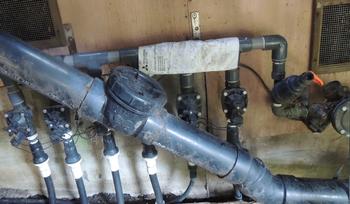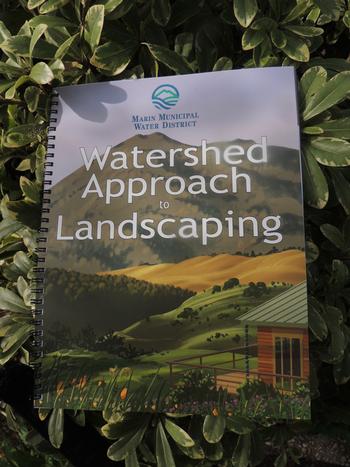Time to tune up your watering system
-
Diane Lynch and Tony Mekisich
-
It’s February and my garden is cracking open as the soil dries out. The good news is that watering systems in central/southern Marin can now be used two days a week before 9 am and after 7 pm. North Marin Water District’s Novato service area is allowing sprinkler use three times a week and drip irrigation as needed.
 Valves aren’t that interesting to look at, but are integral to a drip or sprinkler system. Photo: Diane Lynch
Valves aren’t that interesting to look at, but are integral to a drip or sprinkler system. Photo: Diane LynchEvery spring your irrigation system should be inspected before setting it to run automatically. Rodents love irrigation lines—maybe they’re made of soybeans like my car seats. Your inspection will reveal repairs that need to be made. A clean-up of the garden will make it easier to see where your lines are.
Adjust the timer on your controller to the correct time and days it will run. If you have a backup battery spring is a good time to replace it. If you have a weather sensing system you’ll want to clean the sensors.
Slowly open the main valve and allow the system to fill with water. Manually run each station and look for leaks to be sure water is coming out of each emitter and sprayer. Some may need replacing. Clean all filters.
In the days after your work on your system go out and check to be sure that plants seem to be getting enough water. Water from drip emitters spread out underground so probe around a bit. You’ll need to do this throughout the watering season and adjust run times as the warmest summer months heat up and again in the fall as days get shorter and water needs decline.
Hand watering some of your garden once a week or so is a good way to stay in touch with how every plant is doing. Rules allow hand watering if your hose nozzle has a shut-off.
How much water is your system is using? If you know the gallons per minute each valve uses you can figure out the total amount for each run. For instance, a single zone using 5 GPM that’s on for 30 minutes will use 150 gallons. At two days a week, that’s 2400 gallons per 2-month billing cycle, about 3 CCUs as expressed on your bill. This booklet, published by MMWD, is a good primer for improving your garden. Photo: Diane Lynch
This booklet, published by MMWD, is a good primer for improving your garden. Photo: Diane LynchDo you have a leak? Make sure nothing is running and check your water meter to see if water is flowing. On an older analog meter, the little triangle will rotate slowly if water is on anywhere. Digital systems show any water flow.
Assess your garden layout and consider moving plants with similar water needs near each other if that will fit into your overall design. Note on your calendar to do this in the fall when conditions are better as winter rains approach. If you have plants that are problematic, such as a hydrangea that wilts throughout the summer months if you don’t supplement its water, maybe this is the summer to give it up and consider less thirsty alternatives to be planted in the fall. Having fewer plants in the garden will use less water.
Reading of the recent study that the past two decades have been the driest in 1200 years tells us we all must get serious about using less water. Shrinking lawns in the west is a sensible thing to do. Do the kids really need all that lawn or could it be smaller? Investigate the idea of planting more natives. Many use less water and they benefit local animal and insect populations more because they evolved together and are interdependent.
Marin Water, aka MMWD, has a section on its website called WaterSmart Gardening Resource Center, where a booklet called Watershed Approach to Landscaping is available as a PDF. This very useful booklet, available in hard copy gratis at the main office, 220 Nellen Avenue, Corte Madera, is full of plant lists, landscaping, irrigation information, and much more. It’s well worth using as a guide to improving your garden.


